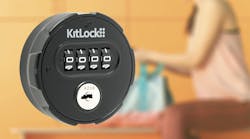TORONTO, Oct. 16 -- Bioscrypt Inc., a leading provider of identity verification technology, announced today that it has selected the UPEK TouchChip TCS1 fingerprint sensor for its new biometric Physical Access Control (PAC) readers. These readers will comply with the U.S. government's Federal Information Processing Standard Publication 201 (FIPS 201), Personal Identity Verification (PIV) program.
Under FIPS 201, a PIV credential (card) with the capacity to store the digital representation of two fingerprints, as ANSI/INCITS 378 standardized templates, will be created for every federal employee and contractor. These fingerprint data can then be used to authenticate individuals, allowing them physical access to buildings and/or logical access to computers.
In practice, a government employee will enroll in the PIV program by having a scan taken of their fingerprints, to create the ANSI/INCITS 378 templates. Those templates are then added to the information that is stored on the card and used for physical and logical access control. For example, when a person attempts to access a building, they will present their card to the biometric PIV PAC reader and place their finger on the sensor integrated into the reader. The information captured by the sensor is then processed by the fingerscan matching algorithm to ensure the template on the card is a match to the live finger. Assuming a match is achieved, the door will open and the person can enter the facility.
To participate as a vendor of biometric PAC readers for the FIPS 201 program, Bioscrypt will submit a newly designed reader to the GSA for qualification. Among the design changes necessary for the existing reader to comply with FIPS 201 requirements is the addition of a PIV-compliant fingerprint sensor.
"We are pleased to be chosen as a fingerprint sensor provider for the Bioscrypt FIPS 201 access control reader," said Mike Chaudoin, Director of Standards and Security at UPEK. "UPEK has architected the TouchChip TCS1 silicon fingerprint sensor to meet the demanding fingerprint image quality requirements specified by NIST and the FBI for Single Fingerprint Capture Devices. The TouchChip TCS1 sensor's compact size, low cost and proven ability to acquire images across diverse populations represent significant advantages in comparison to other fingerprint sensors," added Mr. Chaudoin. "Solutions based on UPEK's TouchChip TCS1 sensors offer excellent value for government customers seeking to implement cost effective and robust fingerprint verification devices for FIPS 201 and other biometric identity programs."
"UPEK's TouchChip TCS1 fingerprint sensor provides Bioscrypt a capacitive fingerprint sensor option which we can offer to government agencies as they procure readers to comply with the new FIPS 201 regulations," said Colin Soutar, CTO Bioscrypt Inc. "The addition of this GSA approved sensor will complement our recently qualified minutiae based algorithm, providing a cost-effective, interoperable and high-performance platform for physical access control under FIPS 201."
Bioscrypt intends to provide a range of products for FIPS 201, for both physical and logical access control. These products will be brought to market through both direct sales and Bioscrypt's wide range of integrators and OEM partners in the physical and logical access control industries.
"The FIPS 201 program is the first large scale deployment of biometrics for verification rather than identification," said Robert L. Williams, President and CEO of Bioscrypt. "Verification has always been our focus, specifically the design of biometric access control technology. Our algorithms are qualified for use as a generator in the PIV issuance system and a matcher for physical and logical verification systems. We believe that we continue to demonstrate real world expertise in bringing biometric verification systems to the market."

